Aquantia Launch AQtion 5G/2.5G/1G Multi-Gigabit Ethernet Cards (NICs) for PCIe
by Ian Cutress on May 15, 2017 8:30 AM EST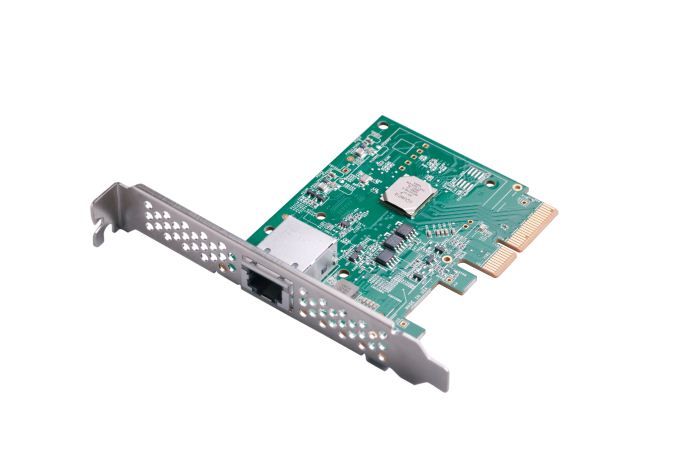
Late last year, Aquantia launched their range of multi-gigabit Ethernet controllers. These were controllers that could enable 1G, 2.5G and 5G connections over standard RJ45 connectors and Cat5e cabling. At the time, the two launched controllers were offered to OEMs to add into their custom motherboard builds, such as enterprise focused machines with a 5G office network in place. We have also seen motherboard manufacturers pick up the mantle, with consumer motherboards such as the ASRock Z270 SuperCarrier and the ASRock X370 Gaming, using the 5G Aquantia AQtion AQC108 chip.
Today's announcement cements Aquantia's lead in the multi-gigabit Ethernet space, despite already having an apparent 2 year lead over other rivals in this space (it helps that Aquantia helped define a major part of the 2.5G/5G specifications in the NBASE-T Alliance). Aquantia is launching two PCIe-based single-port network cards using their AQC108 and AQC107 controllers.
| Aquantia AQtion Multi-Gigabit NICs | ||
| Card | AQN-107 | AQN-108 |
| Controller | AQC-107 | AQC-108 |
| 100BASE-T | Yes | Yes |
| 1000BASE-T | Yes | Yes |
| 2.5GBASE-T | Yes | Yes |
| 5GBASE-T | Yes | Yes |
| 10GBASE-T | Yes | No |
| Ports | 1 | 1 |
| Price (from Aquantia) | $127 | $99 |
| Release Date | Soon | Soon |
| Potential Resellers | ASUS GIGABYTE |
? |
Both of these cards equip a system with a single port, with the AQC108 based card supporting BASE-T standards from 100M to 1G, 2.5G and 5G and uses a PCIe 3.0 x1 interface. The beefier AQC107 based card supports the same standards as well as 10G, and uses a PCIe 3.0 x4 interface (both cards will work down to PCIe 2.0 x1, with reduced data rates). Drivers for both cards will be available for the Windows 7/8/8.1/10 (also as part of the Windows Update solution) as well as varieties of Linux (3.10, 3.12, 3.2, 4.2 and 4.4).
The idea behind these cards is the same as other network cards - to be able to offer functionality without having to embed the controller on the motherboard or into a prebuilt/legacy system. In the consumer world, we have plenty of offerings of Intel and Realtek based gigabit Ethernet cards (even Killer NICs back in the day), and Intel commands the 10GBASE-T cards with its X540 and X550 series. Aquantia is hoping to shake up this market, particularly for businesses and end users willing to invest in 2.5G/5G infrastructure.
One of the big questions surrounding the transition to 2.5G/5G for home and SMB is infrastructure - making sure the network backbone, switches and access points are all capable. The major enterprise network players are already deploying multi-gigabit Ethernet networks to their customers, however it will be a bit longer before commercially available switches for consumers are available. One of the major drawbacks investing in 10GBASE-T in the home right now, aside from the $100-200 per port PCIe cards, is the cost of the switches. This is something Aquantia isn't doing directly, but we have been told that they are working with partners (the typical enterprise players at least) to solve. The depth of those solutions remain to be seen (we've been told similar by 10G switch vendors who had a different interpretation of 'mass market'), but ultimately for this technology to become ubiquitous, we need to see cheaper switches ($25/port), followed by cheap implementations, as we have seen in the last 15-20 years with gigabit Ethernet.
Final pricing is set at $99 and $127, with the 5G card being cheaper over the 10G card. Aquantia stated in the briefing that they are planning to sell the cards direct to consumers, or OEMs can brand the cards in their own style (eg imagine gaming based cards, as we've seen from Gigabyte already, or ASUS and their recently announced ROG Areion 10G card using the AQC107 chip) for their customers. It would be interesting to see if a manufacturer will offer a multi-port card by placing 2-4 chips on the same PCB, even if it requires a basic PLX switch. Four 1G/2.5G/5G/10G ports for $549, anyone?
Review samples are currently being circulated, and I'm discussing with Ganesh the best way to test them, especially as we don't have any 5G switch equipment. We're also looking at angles to test these ports as they appear on motherboards too. Aquantia expects the cards to be on shelves shortly, with branded cards to follow.


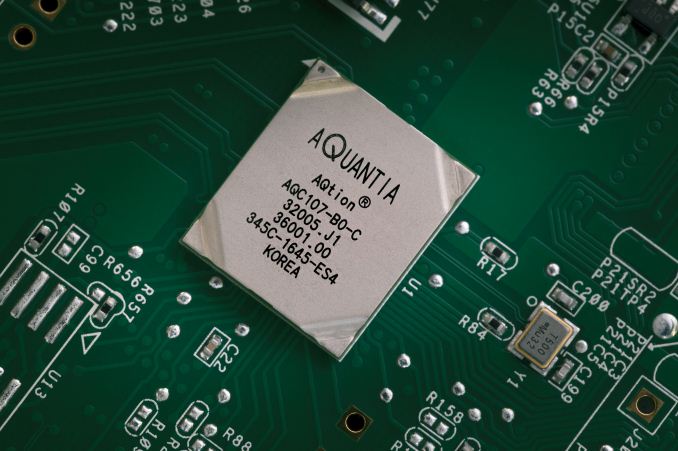
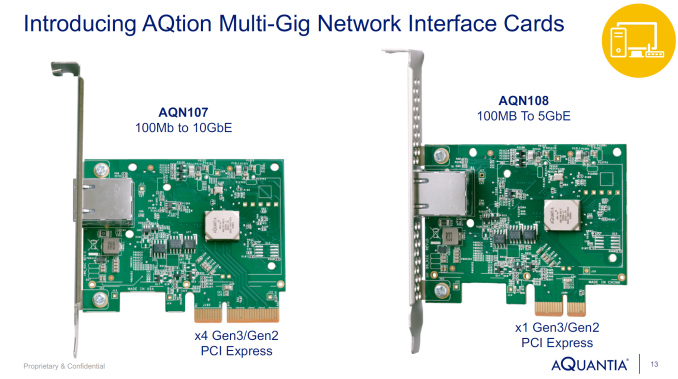
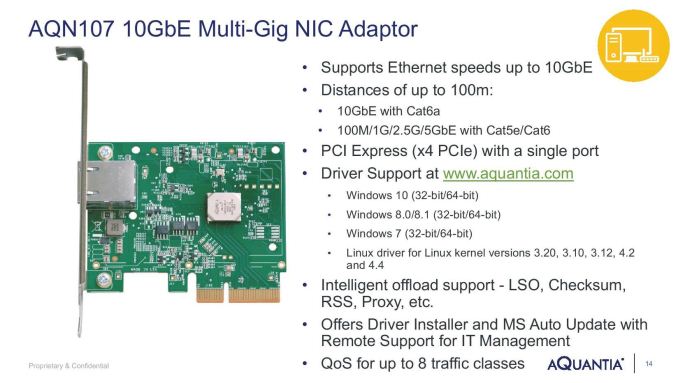
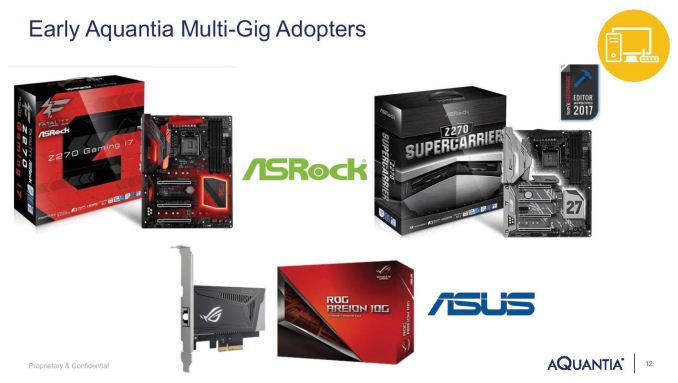
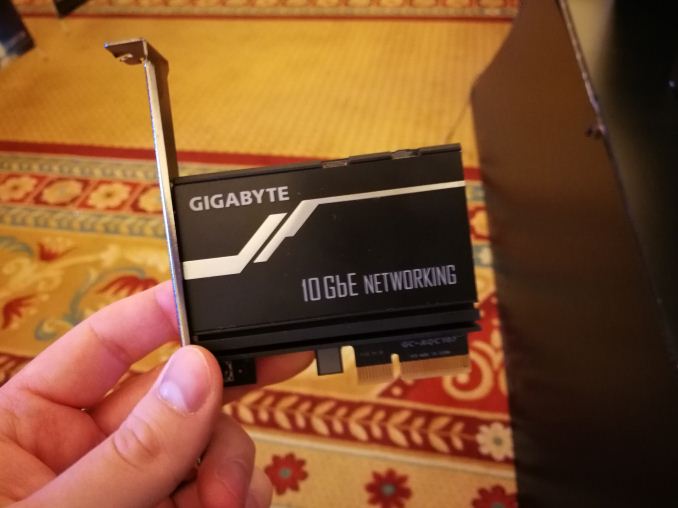




















33 Comments
View All Comments
Xajel - Tuesday, May 16, 2017 - link
I might be speaking of what I see only, but it's a very rare case when a home owner will need to run a 10G for that long.. even fiber run will cost less considering there's a lot of used gadget out there. and those new multi gigabit are still costly considering the need for not just 10G but for 5 & 2.5 as wellJorsher - Thursday, May 18, 2017 - link
I don't think 10gbe would be used much for wiring a building. At least in the enterprise networks I work on, we only use them within the data center. Anything outside goes through fiber.I would use the 5/10gb NIC at home for my ESXi host. The 1gbe ports it already has is sufficient for the 1gbps internet. The 5/10gbe would be great for connecting to the LAN access switch. I could have multiple large file transfers, while some devices are streaming HD from the media server, while the internet is being used to its max, without ever experiencing some bottlenecking on the network side.
The gaming NICs make me chuckle in this case. Perhaps there's a situation I'm not considering, but I'm struggling to find a scenario where I would need 5-10gbps on my gaming PC, considering very few likely have a WAN pipe like that?
I'm glad to see lower-priced options.
chechito - Monday, May 15, 2017 - link
i agree vendors try to boost 10g using (killing 2.5g and 5g) at almost the same pricesaratoga4 - Monday, May 15, 2017 - link
Aside from the cable requirements, the actual phy for 5gbit is almost identical to 10gbit, so it makes sense that they're similarly priced. Aside from the extra pcie lanes, the actual chips are probably identical.The big advantage of 5gbit is that it works with older wiring, not that it saves you a lot on IC costs (which it doesn't).
cdillon - Monday, May 15, 2017 - link
Very much looking forward to this era of Ethernet. 1G hasn't been enough to keep me happy. Link-aggregation isn't always an option, and it's less than ideal even when it is. Traditional 10G is starting to get reasonably priced, but still a but too much for the average home network. A $130 10G NBASE-T adapter is actually a reasonable price, and it can take advantage of existing Cat5e or Cat6.gundul - Monday, May 15, 2017 - link
This is a too long of a wait already..Vatharian - Monday, May 15, 2017 - link
10 GbE switches start to be affordable, especially used ones (ex-enterprise), since there is a push to 40G and above. I highly doubt people will want to invest in technology with half-baked implementation. I'd rather have 16+16 10G/1G rack-mounted switch bought off ebay for $100 and bunch of 10GbE cards that are around $40 each, than $130 cards that *could* possibly connect to some unannounced switches in the future... maybe.thewishy - Monday, May 15, 2017 - link
Ex-enterprise switches tend to be loud and power hungry.D-Link and TP-Link both have 24 1g copper + 4 10g SFP models at the $300-400 mark, Intel x520 cards are cheap on the server pulls market (Especially single port). All in all makes a for a reasonably priced home lab / small enterprise solution.
jabber - Monday, May 15, 2017 - link
Yeah I thought suddenly a while ago..Hey let's buy a used Enterprise 10GbE switch! Then I remembered like you say, it will whine like a whiny thing. Not something I can use domestically.chechito - Monday, May 15, 2017 - link
i dont think used hardware can be market representativethe thing is today 1g ethernet nic costs 10 bucks and a 8 port switch 20 bucks that is 12.5 bucks per port for 8 devices solution.(8 10 bucks nics and 1 20 bucks switch 100us / 8 ports)
i think will be reasonable to pay 30 bucks per complete solution on 2.5g and 60 us for complete solution on 5g
that is 100 bucks for 2.5g 8 port switch and 20 bucks for each 2.5g nic
and 200 bucks for 5g 8 port switch and 40 bucks for each 5g nic
any cost beyond that is far from soho mass market and broad adoption of 2.5 and 5g ethernet